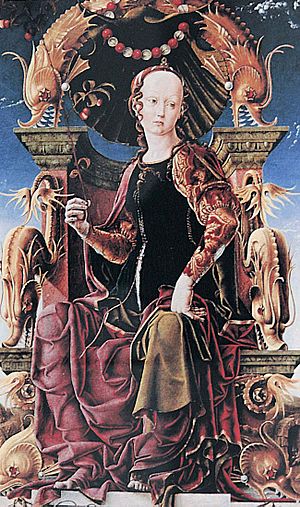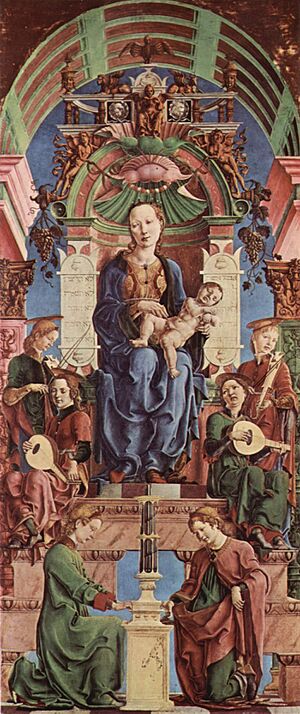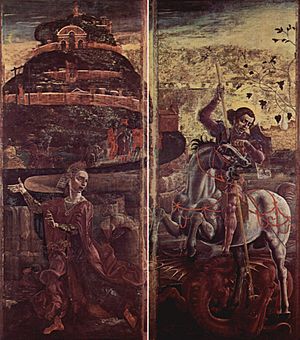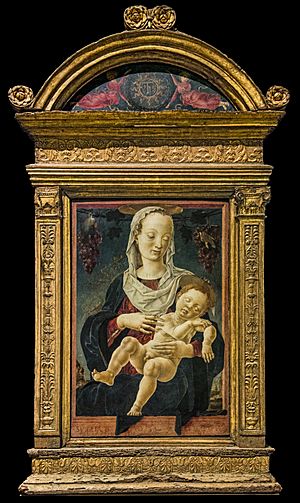Cosmè Tura facts for kids
Quick facts for kids
Cosmè Tura
|
|
|---|---|

An Allegorical Figure (Calliope), c. 1460
|
|
| Born | c. 1430 |
| Died | 1495 |
| Nationality | Italian |
| Known for | Painting |
| Movement | Quattrocento or early-Renaissance |
Cosmê Tura (c. 1430 – 1495) was an important Italian painter. He was also known as Il Cosmè or Cosimo Tura. He lived during the early Renaissance period. Many people see him as one of the main artists who started the "School of Ferrara," a special style of painting from the city of Ferrara.
Contents
Cosmè Tura's Life and Art
How Cosmè Tura Became an Artist
Cosmè Tura was born in Ferrara, Italy, around 1430. His father was a shoemaker, so Cosmè came from a simple family. We don't know much about how he first learned to paint. Some people think he might have learned from a mysterious artist named Galasso Ferrarese.
The first records of Tura's work are from 1451 and 1452. He decorated things for the Este family, who ruled Ferrara. For example, he painted flags with their family symbols and a helmet for a tournament prize. These kinds of jobs were common for artists back then. They helped artists earn a living.
From 1452 to 1456, there are no records of Tura in Ferrara. This makes people think he might have traveled. He probably visited Venice and Padua. Many clues in his paintings suggest he learned a lot there. The Este family might have even paid for his trip because they saw his early talent.
In Padua, Tura likely visited the workshop of Francesco Squarcione. This was a very important art school in northern Italy. Many famous artists, like Andrea Mantegna, learned there. From this experience, Tura developed a clear, sharp style. He also learned to add lots of decoration to his art.
Tura also learned from Piero della Francesca. He might have met him in Ferrara around 1458. Piero taught him how to create paintings with strong shapes and clear light. Tura used this light especially in the backgrounds of his works.
Another big influence was Flemish painting. Flemish art was popular in Ferrara. From these artists, Tura learned to pay close attention to small details. He also learned to make different materials look real using oil paint. He could make gems sparkle and velvet look soft.
Working for the Este Family
In 1456, Tura returned to Ferrara. He became a full-time painter for the Este court. He even lived in the castle, which showed how important he was. He worked for Borso d'Este and later Ercole I d'Este. He never left Ferrara after this.
Cosmè Tura was a very talented and versatile artist. He did many different kinds of art for the Este family. Court artists back then didn't just paint pictures. Tura was a skilled painter, but he also designed sets for parties and tournaments. He decorated furniture, clothes, blankets, and pottery. He even designed patterns for tapestries.
Some of his earliest works include a lost painting for the Ferrara Cathedral door. Paintings like the Madonna and Child with Saints (in Ajaccio) and the Madonna and Child (in Washington, D.C.) are believed to be from this time.
Around 1458, he worked in the Belfiore studio. He continued projects started by another artist, Angelo Maccagnino. He even repainted some of Maccagnino's works.
By 1460, the Ferrara court paid him a regular salary. Some of his students included Francesco del Cossa and Francesco Bianchi.
In the following years, he painted many frescoes (wall paintings). These include works in a chapel in San Domenico (1467) and Stories of the Virgin in Belriguardo (1469-1472). Sadly, these large paintings are now lost.
One of his most famous surviving works from this time is the large organ doors for the Ferrara Cathedral. He finished them in 1469. On one side, he painted the Annunciation (when an angel tells Mary she will have a baby). On the other side, he painted St. George and the Princess. He also helped paint a series of "muses" for a special room called the Studiolo of the Palace Belfiore. One of these is the allegorical figure of Calliope, which is now in London.
Working for Duke Ercole I
When Ercole I d'Este became the ruler in 1471, Tura was made the official court portrait painter. He kept this job until 1486.
The Roverella Polyptych (1470-1474) is a large artwork that is now split into pieces in different museums. It was painted to honor Bishop Lorenzo Roverella. The main part, showing the Madonna and Child with angels, is in the National Gallery in London.
Tura also decorated rooms, studies, and a library for Giovanni Pico della Mirandola. In Ferrara, you can see his frescoes in the Palazzo Schifanoia (1469–71). This palace was owned by the d'Este family. Cosmè Tura, along with Francesco del Cossa and Ercole de' Roberti, created a detailed series of paintings about the months of the year and zodiac signs. These paintings show people, musicians, workers, and carnival parades. This series is considered one of the most unique art projects of the European Renaissance.
Even though Cosmè Tura worked hard for the Este family his whole life, he died tired and not very rich. In a letter from 1490, he asked Duke Ercole for payment for one of his works. He wrote that he didn't know how he and his family would live.
Many of Tura's works were destroyed later because of events in Ferrara's history.
Cosmè Tura's Unique Style
Cosmè Tura's paintings are very special and original. He created richly decorated scenes. His figures often look almost like sculptures. They seem real, but they are also very imaginative.
His colors are bright and sometimes look unreal. This can make his subjects look like they are made of metal or stone. His paintings often have a tense, dreamlike feeling. He combined the detailed style of International Gothic art with the new ideas of the Renaissance from Padua. He also used techniques from Flemish painting. He paid great attention to small details and created unusual landscapes.
Famous Works by Cosmè Tura
- Saint George - San Diego Museum of Art
- Pieta (c. 1460) - Museo Correr, Venice
- Judgment of Saint Maurelius and Martyrdom of Saint Maurelius (1470s) - Pinacoteca Nazionale, Ferrara
- The Circumcision of Christ (1470s) - Isabella Stewart Gardner Museum, Boston
- Madonna and Child (1455) - National Gallery of Art, Washington D.C.
- Portrait of Eleonora d'Aragona, Duchess of Ferrara - Pierpont Morgan Library, New York
- Spring or the muse "Calliope" (1460) - National Gallery, London
- The Princess (1470) - Museo del Duomo, Ferrara
- St. John the Evangelist in Patmos (c. 1470–1475) - Thyssen-Bornemisza Museum, Madrid
- St. George and the Dragon (1469) - Museo del Duomo, Ferrara
- Madonna Enthroned (1474) - National Gallery, London
- St. Sebastian - Gemäldegalerie, Dresden, Germany
- St. Dominic - Uffizi, Florence
- Pietà - Louvre, Paris
- Side Panels from a Portable Triptych Showing Saints Peter and John the Baptist (c. 1473) - Philadelphia Museum of Art
- St. Anthony of Padua Reading - Louvre, Paris
- Saint Nicholas - Musée des Beaux-Arts de Nantes
- St Anthony of Padua (c.1484-1490) - Galleria Estense, Modena
- Letter A, miniature from choirbook (Metropolitan Museum, New York)
See also
 In Spanish: Cosimo Tura para niños
In Spanish: Cosimo Tura para niños




